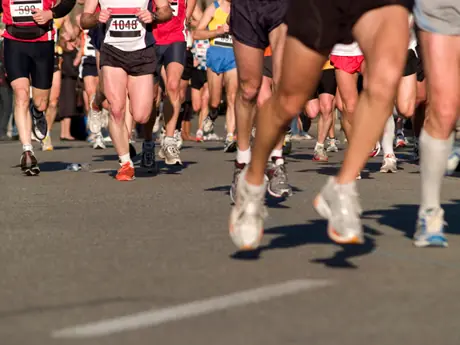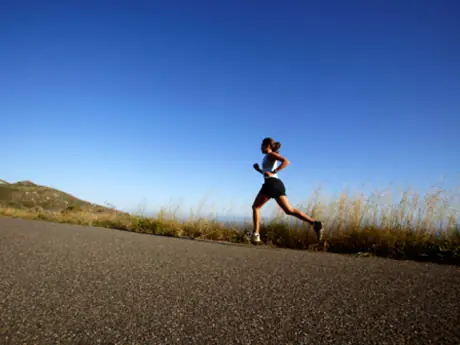The fitness industry has seen unprecedented growth during the past decade, and chances are good that running is no longer our only athletic activity.
In fact, runners often walk, bike, hike, cross-train, lift weights or participate in boot camp, yoga, HITT, CrossFit or any other number of classes during a typical week. And though you may be tempted to streamline your closet by wearing the same pair of shoes for everything, choosing the right shoe for each activity will not only help you get more out of your workout, it can also prevent injury and extend the life of your footwear.
Would you wear a pair of ballet shoes to play soccer? Of course not. Believe it or not, it makes no more sense to wear a pair of long distance daily trainers for a hardcore HIIT session.
The perfect shoe is specific to you and your chosen activity, but it can be tough to sort through the hundreds of shoe options out there. Luckily, there is an easy way to cut through all the noise.
Road Runner Sports offers both online and in-store fitting it calls ShoeDog. Taking into account your physiological profile, preferences and activity, the online tool will help "fetch" the perfect shoe for runners who prefer the convenience of shopping from the sofa. But, for those willing and able to visit one of Road Runner Sports' 41 locations, a ShoeDog gait analysis can be performed in just 10 minutes, taking the individual analysis far more in-depth.
Here are a few tips to help you choose the right type of shoe for whatever training session you have planned.
Road Running Shoes
Size, gender, arch type, mileage and cushioning level are all part of Shoe Dog's algorithm for finding you the perfect running shoe. A good road running shoe will be supportive for your specific body type, with the ability to withstand the mileage you plan to run. Your perfect shoe will also take into account the type of road running you intend to do. Are you a marathoner or just shooting for your first 5K? If you rack up the miles, you'll want to select a shoe that will hold up over the long haul. Your personal preferences for cushion and responsiveness should be taken into account as well.
The profile (heel-to-toe drop) and weight of the shoe can also provide some guidance as to how responsive the shoe may be. Lighter, lower profile shoes may feel more responsive, while more cushioned shoes tend to be slightly heavier with a higher profile. You may even want to select two pairs—one heavily cushioned option for your recovery or long run days and one lighter option for your speed work or track sessions.
Utilizing the descriptions and reviews of the shoes can help you make your final decision. And don't forget to order at least a half-size to a full-size up from what you normally wear, as your feet swell when you run.
Racing Shoes
There's nothing better than lacing up a pair of racing flats and knowing it's time to get it done. If you'll be racing quite a bit, you'll want to make sure you've got the perfect pair of shoes to propel you past the competition.
Racing flats are quite a bit (typically 3 to 4 ounces) lighter than regular trainers and usually feature less cushioning and a much lower profile. The general rule of thumb is that the shorter the race distance, the flatter, lighter shoe you can get away with—depending on how strong your legs and feet are and how often you've trained in minimal profile shoes.
The race distance will make a difference in the level of cushioning you'll need as well. For a 5K, a racer may choose a more snug-fitting minimal flat, while a 10K or half marathon likely requires a roomier, more cushioned shoe.
A lighter shoe means that your body does less work on race day, but it's crucial that you give yourself time to adjust slowly to wearing your flats, as they can stress your calves and feet. Practice wearing them for a few short, easy workouts and then gradually incorporate them into quality workouts as your body adjusts.
Trail Running Shoes
Spectacular scenery, rugged terrain and a thirst for adventure entice runners to embrace the trail running life. Wearing the perfect trail shoe though can mean the difference between an epic run and a massive wipeout.
When choosing shoes for trail running, keep your purpose in mind: Will these be used for loops around your local trail system or weekly trail runs in the mountains? Choose a shoe that makes sense for the types of trails you plan to run the most.
If the majority of your runs will be on soft, muddy surfaces, you want to look for a longer "lug" length (the individual treads of the shoe) to help prevent slips and slides. For runs primarily on hard pack or rocky terrain, a shorter lug length works well. If your trails are especially rocky, you may want to consider a foam or rock plate in the shoe to protect your foot against hard edges. In general, foam is more shock absorbent, but plates provide better foot placement and a more natural feel for the ground. The right shoe profile and cushioning level will depend on your personal preferences. Just don’t overdo the support or you’'l be adding unnecessary weight.
Finally, while purchasing a waterproof shoe may sound cool, the reduced breathability in the membrane means that, as your feet sweat, your shoe is unable to keep up with the excess moisture and you could wind up with some wicked blisters. Unless you are planning on running consistently muddy or snowy trails for long distances, avoid waterproof shoes.
Cross-Training Shoes
Cross-training can be a sort of catch-all term for athletic activities that aren't sport-specific. Many cardio machines, including the elliptical and arc trainer, as well as aerobics classes like Zumba, kickboxing, BodyCombat and step aerobics, require a shoe that supports both vertical movement (jumping, kicking and running) and lateral movement.
The key to selecting a good cross-trainer is to choose a shoe that fits your foot well and provides ample support for the foot and ankle during those quick, side-to-side movements.
Pay attention to the level of traction that the shoe provides. When you try on the shoes, test them out with some side-to-side movements and pivots on the balls of your feet. You want enough grip to prevent excessive sliding. Next, check the fit to make sure it's snug enough to provide stability. Unlike running shoes, you don't necessarily need to go up in size since you won't be experiencing the same amount of foot swelling as runners do over multiple miles.
Once you've found your perfect shoe, a general rule of thumb is to replace them every 80 to 100 workout hours. A simple visual test can be your guide as well. If you notice excessive creasing or wear on the areas of the shoe that absorb the most load (the heel and ball of the foot), it's time to toss them.
CrossFit/HIIT shoes
For high intensity workouts like CrossFit, Boot Camp and HIIT, your primary goal in a shoe should be stability. During weightlifting, your ankles and feet function best with a supported, locked-in feel, so choose a shoe that provides that perfect blend of stability and support.
Several brands offer HIIT-specific shoes that support you through deadlifts, while providing the traction and flexibility to help you crush the box jumps, side-shuffles and ladder work. Similar to the recommendation for cross-training shoes, there's no need to size up when selecting this type of training shoe since you won't be experiencing the same level of swelling as runners. You do want to ensure the shoe has good breathability—look for lightweight wicking fabric or mesh panels—so that when you hit your fourth round of mountain climbers you aren't thinking about how much your feet are sweating. Finally, you want to look for traction in both the outsole and midfoot. The former will support those fast, lateral movements, while the latter will help you conquer those rope climbs.
A good shoe can often be the difference between a new personal best and a lackluster workout. Your time is too valuable to skimp on the footwear that makes every minute of your workout count. To get the most out of your next training session, choose the right shoe for the job and get after it!
Get ACTIVE on the Go


Couch to 5K®
The best way to get new runners off the couch and across the finish line of their first 5K.
Available for iOS | Android







Discuss This Article